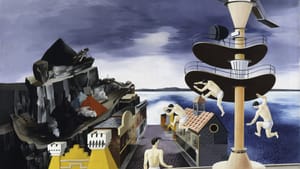Stay in the Loop
BSR publishes on a weekly schedule, with an email newsletter every Wednesday and Thursday morning. There’s no paywall, and subscribing is always free.
Being in with the In Crowd
Peter Blume: Nature and Metamorphosis, at PAFA

Peter Blume, Nature and Metamorphosis is an illuminating time machine taking us back to the 20th century as ancient history, or maybe just a reprise of events you remember your parents talking about. He painted people and places in a style often described as surreal, a term rejected by the artist. It is the first retrospective of his art since 1976, paintings of males and females who look like us and landscapes often seen from our windows.
The show includes 56 paintings and 103 drawings installed chronologically, as if you have lived through the whole history with the “in crowd” of artists, writers and composers, including Blume, all of whom eventually decamped to Connecticut. Drawings and painted studies accompany each of his major paintings, giving us an insider’s view of all the preparatory work involved.
Blume’s early landscapes, such as New England Barn and Maine Coast (both 1926), capture the tradition of American landscape painting with the sexual vibes of a 20-year-old. Then he grew up, matured, and saw the world as a subject beyond sex, seeing the politics of nations with their obsession for power that could threaten the lives of individuals. Parade (1929-30) describes this dynamic. The crowd is dwarfed by the industrial forms of a new ship; one man carries a knight’s armor on a pole.
South of Scranton (1930-31) catapulted Blume to wide recognition; four young males doing calisthenics, running and jumping in the water under a storm-darkened sky. He did the painting after viewing Nazi soldiers in training. Fascism was rising, and Blume, of Russian Jewish parents, was keenly aware of its threat to individuals.
 Having received a Guggenheim Fellowship to Italy in 1932, Blume became a repeat visitor, fascinated by peoples’ lives being lived among all the antiquities. One of his major paintings is The Eternal City (1934-37). It is Rome, of course, and is an indictment of Fascist dictator Benito Mussolini, portrayed as a jack-in-the-box with an odious blue head, bulging eyes, and swollen lips. He is in a city of ancient ruins, sculptural fragments, and new architecture with vignettes of daily life including a beggar woman and rebellious mobs.
Having received a Guggenheim Fellowship to Italy in 1932, Blume became a repeat visitor, fascinated by peoples’ lives being lived among all the antiquities. One of his major paintings is The Eternal City (1934-37). It is Rome, of course, and is an indictment of Fascist dictator Benito Mussolini, portrayed as a jack-in-the-box with an odious blue head, bulging eyes, and swollen lips. He is in a city of ancient ruins, sculptural fragments, and new architecture with vignettes of daily life including a beggar woman and rebellious mobs.  The Rock (1945-48) shows the frenzy of rebuilding after the destructive war, an amazing metamorphosis.
The Rock (1945-48) shows the frenzy of rebuilding after the destructive war, an amazing metamorphosis.
Don’t miss the small painting House at Falling Water (1938-68), commissioned by the Kaufmann family, who wanted a painting of their house — designed, of course, by Frank Lloyd Wright — showing their family and friends enjoying the place. They liked it so much they commissioned him to do a much larger one that became his nemesis over the next two decades.
Tasso’s Oak (1957-1960), with all its preliminary sketches and studies, envelops multiple aspects of life. Torquato Tasso was an illustrious Roman poet of the 16th century. In his last years, he often sat under his favorite tree on the Janiculum hill in Rome. After his demise and the later death of the tree, its remains were preserved as a historical marker, propped up by metal beams. Blume’s painting illustrates the many phases of life that continues forever: lovers, children playing, nuns, and old ladies knitting and watching.
Above right: The Eternal City (The Museum of Modern Art, New York) and The Rock (The Art Institute of Chicago). Both © The Educational Alliance, Inc./Estate of Peter Blume/Licensed by VAGA, New York
For Robert Zaller's review of the PAFA show and an associated show at ACA Galleries in New York, click here.
What, When, Where
Peter Blume: Nature and Metamorphosis, through April 5, 2015 at the Pennsylvania Academy of the Fine Arts, Samuel M.V. Hamilton Building, 128 North Broad Street, Philadelphia. 215-972-7600 or www.pafa.org.
Sign up for our newsletter
All of the week's new articles, all in one place. Sign up for the free weekly BSR newsletters, and don't miss a conversation.
